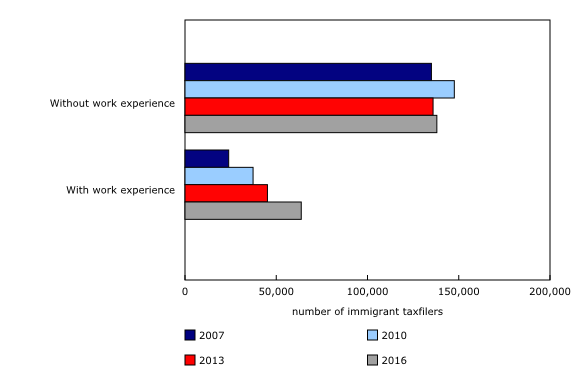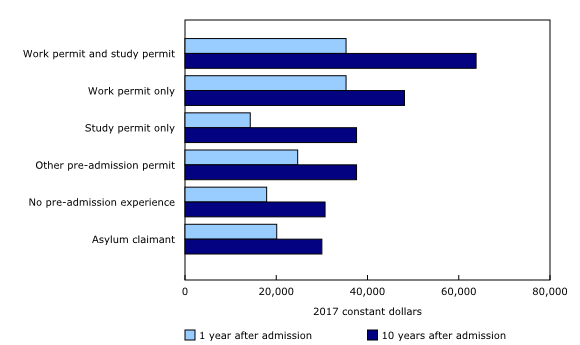Changes in outcomes of immigrants and non-permanent residents, 2017
Archived Content
Information identified as archived is provided for reference, research or recordkeeping purposes. It is not subject to the Government of Canada Web Standards and has not been altered or updated since it was archived. Please "contact us" to request a format other than those available.
Released: 2019-12-16
Immigrants admitted to Canada in 2016 reported a median entry wage of $25,900 in 2017, the highest recorded among immigrants admitted since 1981. Although the entry wages of recent immigrants have increased over the past few years, their income remains lower than that of the overall Canadian population. The Canadian Income Survey estimated the Canadian population's median wage at $36,100 in 2017.
When immigrants arrive in Canada, they face a number of challenges, such as getting their credentials recognized, being able to speak one of the official languages and acquiring Canadian work experience. However, the longer immigrants live in Canada, the more their income increases and, for some, their income reaches the level of the overall Canadian population.
This analysis uses new data from the Longitudinal Immigration Database (IMDB), which comprises information on permanent and non-permanent (temporary) residents, including asylum claimants. It presents the type of information that can be extracted from the IMDB and its outputs to better understand how the socioeconomic situation of these individuals has evolved.
Recent immigrants have higher entry wages and more work experience prior to admission than before
Over the past 10 years, the median entry wage of immigrants, one year after admission, in 2017 constant dollars, has increased from $20,400 for the 2007 admission year to $25,900 for the 2016 admission year (+27%).
Not all immigrants face the same challenges after admission. Those who had work experience in Canada upon admission reported the highest median entry wages. For the 2016 admission year, income one year after arrival was $39,800 for study and work permit holders, and $38,100 for work permit holders only. These wages are comparable with those of the entire Canadian population. For immigrants who had no experience prior to admission, or who had a study permit only, incomes were $19,900 and $12,500, respectively.
In recent years, an increasing number of non-permanent resident permit holders are transitioning to permanent residence. The observed growth in entry wages can be partly accounted for by differences in income between immigrants with pre-admission work experience in Canada and immigrants without such work experience. From the 2007 admission year to the 2016 admission year, the number of immigrant taxfilers one year after arrival who had work experience in Canada increased by 166%, while the number of immigrants without work experience rose 2%.
Immigrants who hold at least a pre-admission study permit have stronger wage catch-up in the 10 years after admission
Overall, immigrants' wages increase with the number of years since admission and, for some, their wages eventually reach that of the overall Canadian population ($36,100). For example, the median wage for immigrants admitted in 2007 increased from $20,400 in 2008 to $33,500 in 2017, an increase of 64%.
Wage catch-up factors include pre-admission work experience, which facilitates integration through increased knowledge of official languages and the development of professional networks in Canada, among other things. In 2017, immigrants admitted in 2007 who had held both a study permit and a work permit prior to admission had the highest median wage (up 81% to $63,800), and their wage exceeded that of immigrants who held only a work permit (up 36% to $48,100) and that of Canadians as a whole. The median wage of immigrants admitted in 2007 who held only a pre-admission study permit increased significantly over 10 years (up 163% to $37,600) and now exceeds the median wage of immigrants without pre-admission experience (up 72% to $30,700).
The median wage for asylum claimants increases with length of residence in country
Asylum claimants are individuals who request refugee protection in Canada. Because of their situation, they face many challenges in terms of economic integration. Even after their refugee claim is accepted, asylum claimants have lower median wages than other immigrants with pre-admission experience.
According to a Statistics Canada article on asylum claimants published earlier this year, the number of claimants fluctuated from 2000 to 2018 and reached over 50,000 in 2017 and 2018. Asylum claimants are relatively young. Of those who arrived in 2017, 39% were younger than 25 years of age, while 14% were aged 45 or older.
The median entry wage for asylum claimant taxfilers refers to their income one year after they submitted their refugee claim. Among those who claimed refugee status from 2006 to 2016, the median wage fluctuated between $10,900 and $16,000. As with immigrants, the median wage of asylum claimants increases with each additional year spent in the country. Therefore, the median wage for those who submitted a refugee claim in 2006 was $14,100 in 2007 and $28,600 in 2017.
There are significant differences in income among the top 15 countries of origin for asylum claimants. Among asylum claimants in 2012 who filed taxes in 2017, the highest median wages were reported by claimants from Sri Lanka ($31,600), Somalia ($30,700) and Nigeria ($30,700). Claimants from Afghanistan ($18,200), Iraq ($17,300) and China ($14,300) reported the lowest median wages.
Economic immigrants and their dependants stay more frequently in their province of admission when they have pre-admission work experience
Reasons for immigrating to Canada can influence the likelihood of immigrants to remain in their province of admission over time. For example, family class immigrants come to Canada to be closer to their loved ones, while economic immigrants are selected based on their ability to contribute to the Canadian economy.
In 2017, 86% of immigrant taxfilers admitted in 2012 filed a tax return in their province of admission. The provincial retention rate was highest among family-sponsored immigrants (93%) and slightly lower among refugees (87%). For economic immigrants and their dependants, the retention rate was 82%. However, for these immigrants, the rate was higher among those with a pre-admission work permit only (90%) than among those with no pre-admission experience (81%).
Note to readers
Definitions and concepts
The Longitudinal Immigration Database (IMDB) is a comprehensive source of data that plays a key role in understanding the economic behaviour of immigrants and non-permanent residents. It is the only annual Canadian dataset that allows users to study the characteristics of immigrants to Canada at time of admission and the economic outcomes and regional mobility of immigrants over a period of more than 35 years.
The IMDB is the result of a partnership between Statistics Canada; Immigration, Refugees and Citizenship Canada (IRCC); and the provinces.
The IMDB combines administrative files on immigrant admissions and non-permanent resident permits from IRCC with tax files from the Canada Revenue Agency (CRA). IRCC's administrative records contain extensive information on immigrants admitted to Canada since 1952. They also include information on non-permanent residents who have been granted a temporary resident permit since 1980. Fiscal data are available from the CRA's tax files for immigrant taxfilers admitted since 1980. Tax records for 1982 and subsequent years are available for immigrant taxfilers.
The IMDB links short-term and long-term outcomes to characteristics at admission, such as immigrant admission class, country of origin and knowledge of official languages. The IMDB also provides information on pre-admission experience in Canada and citizenship acquisition since 2005.
For additional information regarding the data coverage and data quality of the IMDB, users should refer to the 2018 Longitudinal Immigration Database Technical Report.
The IMDB is updated annually. From year to year, there have been changes to data processing. Each yearly update is independent.
This release analyzes income based on the medians of wages (for the population with income from wages, salaries or commissions, excluding self-employment income). The median is the level of income at which half of the immigrant taxfilers have higher income and half have lower. Zeros values are not included in the calculation of medians for individuals.
All income estimates are expressed in 2017 constant dollars to factor in inflation and enable comparisons across time in real terms.
Work experience refers to immigrants who held only work permits or those who held both work and study permits prior to their admission to Canada. Asylum claimants with work permits are not included.
Provincial retention rate in this analysis refers to the proportion of taxfilers that remained in the country and in their province of destination five years after admission.
Family-sponsored immigrant categories include immigrants who were sponsored to come to Canada by a family member who is a Canadian citizen or permanent resident.
Refugee categories include immigrants who were granted permanent resident status on the basis of a well-founded fear of returning to their home country. These include government-assisted refugees, privately sponsored refugees, refugees admitted in Canada and their dependants.
Economic immigrant admission categories include immigrants who have been selected for their ability to contribute to Canada's economy through their ability to meet labour market needs, own and manage or build a business, make a substantial investment, create their own employment, or meet specific provincial or territorial labour market needs.
Asylum claimants are individuals who request refugee protection upon or after arrival in Canada. Refugee claims can be received at a port of entry, at a Canada Border Services Agency inland office or at an IRCC inland office. Claims are then referred to the Immigration and Refugee Board of Canada. While their application is being considered, asylum claimants are considered non-permanent residents in Canada.
Taxfilers are immigrants and asylum claimants who have filed a tax return for a given tax year.
The province of admission is the province of intended destination.
Country of origin is the birth country.
In the context of this release and its associated products, China excludes Hong Kong and Macao.
For a more detailed description of the immigrant admission classes, see the IRCC Glossary.
Source on income of Canadians: Statistics Canada. Table 11-10-0239-01, Income of individuals by age group, sex and income source, Canada, provinces and selected census metropolitan areas.
Statistics Canada publication on asylum claimants: Statistics Canada (2019), "Just the Facts: Asylum claimants."
Products
The data visualization tools "Longitudinal Immigration Database (IMDB): Interactive app" and "Longitudinal Immigration Database (IMDB) Interactive Application: Mobility" are now available.
The product "Longitudinal Immigration Database (IMDB) Technical Report, 2018," part of the series Analytical Studies: Methods and References (11-633-X), is also now available.
The products are available on the Immigrant and Non-Permanent Resident Statistics Portal, which was posted today. The portal was designed to provide easy and free access to immigrant and non-permanent resident data and publications. This information is organized into broad categories, including analytical products, data products, reference materials and interactive applications.
The 2018 IMDB is now available upon request.
New data on the Quebec experience program are now available in the IMDB.
Contact information
For more information, or to enquire about the concepts, methods or data quality of this release, contact us (toll-free 1-800-263-1136; 514-283-8300; STATCAN.infostats-infostats.STATCAN@canada.ca) or Media Relations (613-951-4636; STATCAN.mediahotline-ligneinfomedias.STATCAN@canada.ca).
- Date modified:



